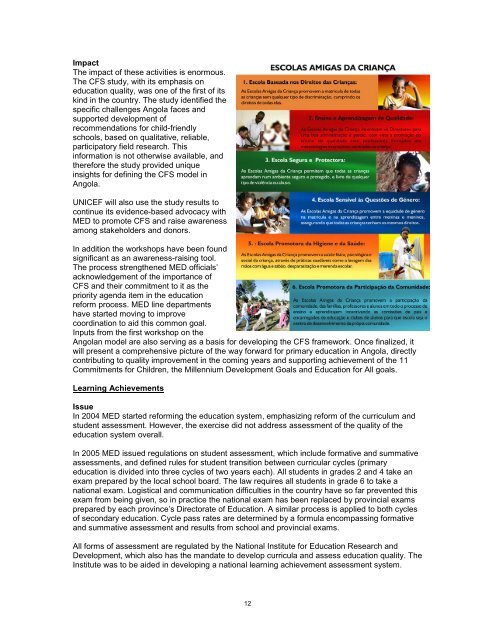Angola Progress Report 2009
Angola Progress Report 2009
Angola Progress Report 2009
Create successful ePaper yourself
Turn your PDF publications into a flip-book with our unique Google optimized e-Paper software.
Impact<br />
The impact of these activities is enormous.<br />
The CFS study, with its emphasis on<br />
education quality, was one of the first of its<br />
kind in the country. The study identified the<br />
specific challenges <strong>Angola</strong> faces and<br />
supported development of<br />
recommendations for child-friendly<br />
schools, based on qualitative, reliable,<br />
participatory field research. This<br />
information is not otherwise available, and<br />
therefore the study provided unique<br />
insights for defining the CFS model in<br />
<strong>Angola</strong>.<br />
UNICEF will also use the study results to<br />
continue its evidence-based advocacy with<br />
MED to promote CFS and raise awareness<br />
among stakeholders and donors.<br />
In addition the workshops have been found<br />
significant as an awareness-raising tool.<br />
The process strengthened MED officials’<br />
acknowledgement of the importance of<br />
CFS and their commitment to it as the<br />
priority agenda item in the education<br />
reform process. MED line departments<br />
have started moving to improve<br />
coordination to aid this common goal.<br />
Inputs from the first workshop on the<br />
<strong>Angola</strong>n model are also serving as a basis for developing the CFS framework. Once finalized, it<br />
will present a comprehensive picture of the way forward for primary education in <strong>Angola</strong>, directly<br />
contributing to quality improvement in the coming years and supporting achievement of the 11<br />
Commitments for Children, the Millennium Development Goals and Education for All goals.<br />
Learning Achievements<br />
Issue<br />
In 2004 MED started reforming the education system, emphasizing reform of the curriculum and<br />
student assessment. However, the exercise did not address assessment of the quality of the<br />
education system overall.<br />
In 2005 MED issued regulations on student assessment, which include formative and summative<br />
assessments, and defined rules for student transition between curricular cycles (primary<br />
education is divided into three cycles of two years each). All students in grades 2 and 4 take an<br />
exam prepared by the local school board. The law requires all students in grade 6 to take a<br />
national exam. Logistical and communication difficulties in the country have so far prevented this<br />
exam from being given, so in practice the national exam has been replaced by provincial exams<br />
prepared by each province’s Directorate of Education. A similar process is applied to both cycles<br />
of secondary education. Cycle pass rates are determined by a formula encompassing formative<br />
and summative assessment and results from school and provincial exams.<br />
All forms of assessment are regulated by the National Institute for Education Research and<br />
Development, which also has the mandate to develop curricula and assess education quality. The<br />
Institute was to be aided in developing a national learning achievement assessment system.<br />
12

















